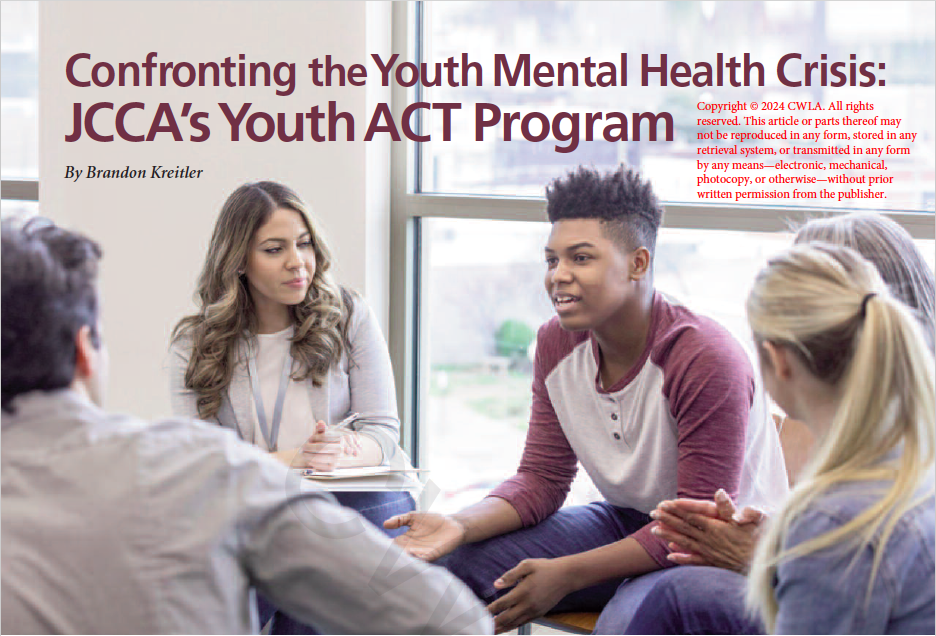Note: reprinted with permission from Children’s Voice magazine, Volume 33, Number 1
The current crisis affecting mental health among young people has been widely reported, and the data are stark. The CDC reports mental health–related emergency room visits among teens increased by 31% during the pandemic. In New York, the Coalition for Behavioral Health reports that the pandemic sparked a 77% increase in demand for behavioral health services. Teen suicide is on the rise, as are depression, anxiety, and disordered eating.
For providers, this epidemic isn’t abstract. “All these numbers are things we see on the ground,” says Ricardo Bermudez, Director of JCCA’s Youth ACT program, the first in New York City. Bermudez and his team treat young people on verge of crisis––clients who’ve recently returned from, or are at risk of, psychiatric hospitalization. These crises take the form of suicide attempts and other self-harm, incidents of psychosis, and concerning behavior at home or school. “We have clients with eating disorders, clients who’ve been violent,” Bermudez notes. “We have youth on probation and young women who run away to the extent that we’re concerned about sex trafficking.” Underlying such behaviors are a range of complex and at times overlapping diagnoses––schizoaffective disorder, ADHD, ODD, anxiety, depression. Abby Jeffrey, a JCCA Assistant Vice President who oversees Bermudez and the Youth ACT program, notes that presentations of illness and serious emotional disturbance (SMD) have gotten more severe, and increasingly appear in younger clients.
All this paints a worrying picture, but providers and policymakers are taking new steps to address these issues, and the Youth ACT treatment model is notable among them. Assertive Community Treatment (ACT) traces its origins to the 1960s, when a push was made to deinstitutionalize patients in residential mental health facilities. ACT programs aimed to serve an adult population that had the potential to function successfully in the community, but for whom traditional outpatient services proved insufficient. In response to the more comprehensive and interconnected needs of such individuals, ACT teams offered an intensive, integrated, and interdisciplinary form of care that left fewer “cracks” for a client to fall through.
Recognizing both the efficacy of the ACT model for adults and the acute nature of the mental health crisis among youth––one exacerbated by staffing shortages and a limited supply of hospital psych beds––New York’s Office of Mental Health approached JCCA, a child welfare and behavioral health organization with a 200-year history, about forming a Youth ACT team in the city. The program, which serves young people ages 10-21, was launched in May of 2022.
“We jumped on the opportunity because it fits perfectly into our vision of providing continuum of care,” Jeffrey remarks. “Youth ACT fills a crucial gap between lighter-touch outpatient services and full-scale residential or institutional care. It was a great resource for kids we were already working with, as well as a way to address a really pressing need in the city.”
The approach of JCCA’s team is personalized, adaptable, and intensely collaborative. In contrast to the most forms of social work, which assign clients to individual staff, the ACT team shares a single caseload. The interdisciplinary team––which combines psychiatric and social work expertise––communicates daily about the needs and progress of each client. “Being on an ACT team is like running a relay race,” Bermudez says. “The baton is handed off to other members of the team to cover all dimensions of support. And the conversation between team members is more or less constant.”
This highly-coordinated, multidimensional is pivotal for hard to reach clients. The team meet with clients at least twice a week and provides a spectrum of services tailored to each client’s specific and interconnected needs: individual and family therapy, medication management, advocacy in the school, in the home, sometimes in court. “We’ll basically do anything and everything that might make a difference,” Bermudez notes. “We’ll write letters to HRA for clients. We just got a client a furniture grant. We got a support animal approved. I wrote a letter to HUD because a client who was fighting with sibling needed an extra bedroom. We’ve attended suspension hearings and IEP meetings at the school. I joke that the ‘A’ in ACT is for ‘annoying’ because we interface with our clients so frequently and in so many aspects of life.”
An example might help illustrate what this full-spectrum support looks like in practice. The very first Youth ACT enrollee was referred after a series of suicide attempts, most of which were related to overdosing on psychotropic medication. The client’s mother, who was struggling with a high-risk pregnancy at the time, was overwhelmed by her adolescent’s psychiatric needs, and at a loss as to how to support him. The Youth ACT team was able to address this family’s needs on several levels. They purchased a lock box for the youth’s medications, removing an immediate risk of self-harm. They provided treatment to the youth to address his mental health needs, while simultaneously supporting the mother through psychoeducation and collateral treatment. This combination of interventions has helped this youth to avoid hospitalization.
“These young people are dealing with very difficult things at a very vulnerable time of life,” says Chana Lerner, a Mental Health Professional on the team. “It’s delicate work.” Nathalie Contreras, a clinical support professional, adds “This is an important time [before full adulthood] to intervene. We’re trying redirect so our clients don’t end up somewhere worse down the line.”
The results have so far been positive, and as recognition of the crisis grows, the model is set to expand with it. According to OMH, there is now a Youth ACT team either launched or about to launch in each NYC borough, and they anticipate that 20 teams will be operational across the state by next year. JCCA staff recently met with officials from New Jersey who hope to launch their own Youth ACT programs in the near future.
“Our message is simple,” Lerner adds. “We’re here for these kids––and we’re not going to give up.”
